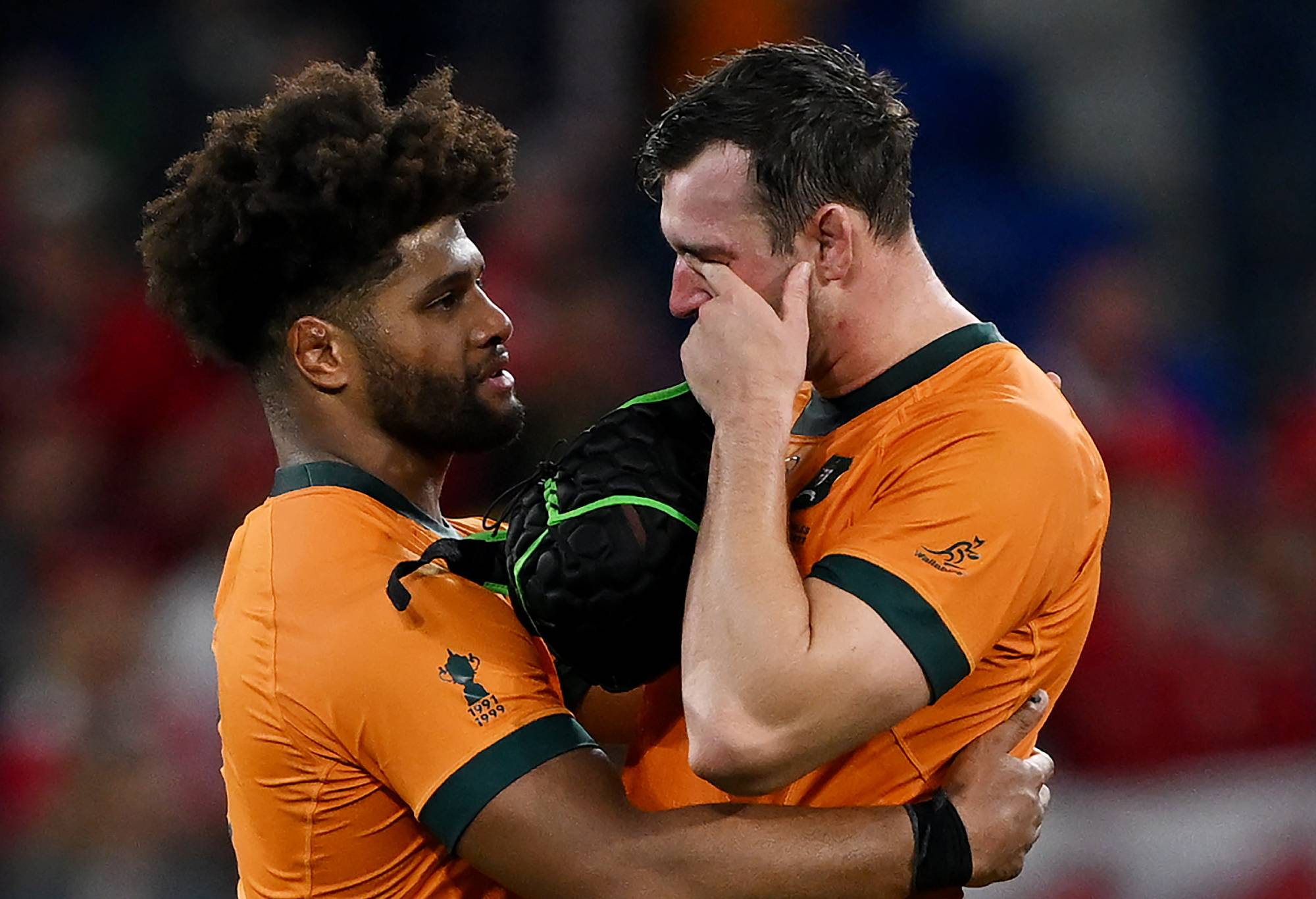
Going through each position group to determine which unit is better
Since Week 13, the 49ers had the third-highest offensive DVOA in the NFL compared to Dallas’s 14th ranking. One team sputtered down the stretch, primarily due to turnovers, while the other flourished. The question posed in the headline may seem one-sided, but let’s go through each position to determine who has the advantage.
Quarterback
Numbers rarely tell the whole story for any position, and that’s no different for Brock Purdy and Dak Prescott. On the surface, Purdy had a 13/4 touchdown to interception ratio averaging 8.1 yards per attempt.
Prescott, in 12 games, had a 23/15 touchdown to interception ratio while averaging 7.3 yards per attempt. Prescott’s interceptions down the stretch were the talk of the internet, as he turned the ball over 11 times in the final seven games — a handful of those weren’t on Dak.
Despite the difference in interceptions, Prescott’s turnover-worthy throw percentage was only one percent higher than Purdy’s. In comparison, Prescott earned a significantly higher “big time throw” percentage from PFF at 4.5 percent compared to Purdy’s 1.7.
Purdy is more of a “gunslinger” than Prescott, who rivals a computer the way he goes through his reads and quickly distinguishes what the defense is doing in coverage.
I love this read. it’s what’s been missing for the 49ers. folks saw Deebo running open and thought the ball should go there.
The safety will tell you what to do. Once he nails down on Deebo, Purdy fires it deep to Aiyuk, who stops running for w/e reason. That’s a TD/DPI if not. pic.twitter.com/NFgw56H4gu
— KP (@KP_Show) January 16, 2023
Since his sophomore season at Iowa State, Purdy has passed up the underneath route for the deep ball. So the play above is nothing new. Also, for the record, Aiyuk is the first read, and that’s where the ball should go, according to Kyle Shanahan’s playbook:
/cdn.vox-cdn.com/uploads/chorus_asset/file/24368622/Screenshot_2023_01_18_at_8.07.23_AM.png)
Anyway, if we are using games late in the regular season to debate which player you’d rather have, what Prescott did against the Jaguars and Eagles was more impressive than what Purdy did in any of his starts.
That’s no slight to the 23-year-old-rookie who has the strongest supporting cast in the NFL, but it must be factored in. Prescott was surgical in the Wild Card round, while Prescott’s early jitters make this decision relatively easy.
Edge: Cowboys
Running back
Christian McCaffrey would have had 1,000 yards rushing and receiving had he played with the 49ers all season. However, Elijah Mitchell proved to be quite the change of pace back. He only had 45 carries during the regular season, but he averaged an eye-popping 6.2 yards per carry.
The Cowboys have a solid duo, as Tony Pollard was third in the NFL in rushing yards over expectation and surpassed the 1,000-yard mark while averaging 5.2 yards per carry. Zeke Elliott may no longer have the burst he once did, but he’s one of the best pass-protecting backs in the NFL and terrific in short-yardage situations.
Both are two of the most explosive backs in the NFL. From Week 10 on, Pollard had the third-best percentage of carries that went for at least 15 yards, while McCaffrey finished fifth. Zeke was right behind McCaffrey at sixth — he’s no slouch.
Pollard and McCaffrey had a 50 percent success rate on the season, but CMC more than doubled Pollard’s receiving output.
Pollard and McCaffrey were among the league leaders in yards after contact and broken tackle percentage, but Christian’s added value through the air gives the 49ers the edge.
Edge: 49ers
Pass catchers
CeeDee Lamb is an exceptional talent who makes his hay in the slot. Lamb finished sixth in the NFL in receiving yards this season but earned the third-most points, according to Sports Info Solutions. Here’s how the ten best pass catchers on each team stack up per SIS. Think of Total Points Earned like WAR (Wins above replacement):
Lamb – 45
George Kittle – 38
Deebo Samuel – 30
Brandon Aiyuk – 27
Dalton Schultz – 21
Jake Ferguson – 11
Ray-Ray McCloud – 7
Jauan Jennings – 7
Noah Brown – 2
Micahel Gallup – 2
Samuel averaged nine yards after the catch, which was comfortably the highest mark for any player with more than 50 targets in the NFL.
This may not come as a surprise, but Jennings had the highest first-down rate at 65 percent, which is slightly ahead of Gallup’s 64 percent, and not too far ahead of Lamb and Aiyuk.
Speaking of BA, his last target was a drop, but he only had four all season, which would give him the best drop rate (4.3%) among the top wideouts.
Deebo had more than double the broken tackles as second place Aiyuk, who had one more than Lamb. However, that doesn’t feel like a fair comparison, as it often takes multiple defenders to drag Samuel down.
I’d take Lamb before I’d take either of the 49ers receivers. But I’d take Kittle, Samuel, and Aiyuk in any order before the next Cowboys pass-catcher. Since this is a team sport and we’re going by the position group, the Niners have the better and deeper group of weapons, and that’s proven itself throughout the season.
Schultz is fine but more of a product of playing in Dallas’s system, while the other receivers left enough to be desired for Dallas to sign 33-year-old T.Y. Hilton in December. That says it all.
Edge: 49ers
Offensive line
If Prescott or Purdy don’t have time, the weapons won’t matter. Dallas couldn’t get much of anything going on the ground against Tampa Bay. They averaged four yards per carry on 32 attempts, with that number being propped up by a pair of Pollard carries that went over 15 yards.
The Cowboys had to shuffle around some players due to injuries, but this is their best lineup. Tyron Smith played the final four games at right tackle. Tyler Smith is a rookie but a rockstar.
PFF grades are a bit too subjective for my liking, so we’ll reference Total Points Earned to give an idea about how each player performed this season:
Biadasz – 38
Martin – 38
Brendel – 34
Tyler Smith – 27
Williams – 26
McGovern – 25
McGlinchey – 24
Banks – 22
Burford – 16
Daniel Brunskill -15
Tyron Smith – 4
I’ve included Brunskill as both he and Burford have split time at right guard, and that remained the case in the playoffs, where Burford only played two more snaps than Brunskill.
The 49ers are fourth in the NFL in adjusted line yards at 4.7, while the Cowboys are 17th at 4.3. Evaluating offensive linemen can be challenging because you can’t ignore the scheme or quarterback.
For example, the Niners had the third-fewest sacks in the NFL, but we know Kyle Shanahan goes out of his way to quickly get the ball out of the quarterback’s hands. As a result, PFF gave the 49ers the third-highest pass-blocking efficiency grade, while Dallas was 11th.
This one is too close to call. I like San Francisco on the ground, but Dallas as individual pass protectors.
Edge: Tie


















You must be logged in to post a comment Login